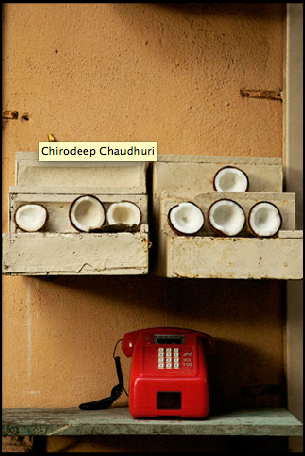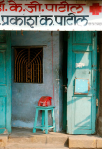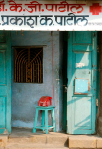Don’t we all remember, damn! it is possible to forget that a large section of India are under 20 where the latest nokias and motos give one instant amnesia, but for the rest of the growing minority, with memories of socialism and ‘nonalignment’, embedded in our national subconsciousness, is the fact that until rather recently it took up-to 5 years to get a ‘legal’ landline. When the phone did arrive it invariably was black bakelite and could be used to bludgeon the ubiquitous MTNL Yadav on the noggin when it didn’t work, and that was often enough.
The pay-phone was a large equally ugly, black device with a rotary dial and a chain that kept the hand-piece attached to the caged telephone, dont we remember cussing and swearing and kicking the instrument when it swallowed your last rupee coin and you had to report home that you were going to be late.
Chirodeep Chowdary’s exhibition of photographs is of a current generation of I Rupee Phones that are not black and not yet mobile enough to wander un tethered. The photographs document playfully the way Indians will use every square inch of space available to them to put in devices to increase revenue. All the while depicting the indian aesthetic that remains vehemently non geometric, where straight lines and ‘finish’ are only meant for engineers.
We’ve seen all the phones before, the locations, the incongruity, the ubiquitousness, and the ridiculousness sometimes, but because they have just been so utility orientated no one till Chirodeep has thought to make of them an artistic statement. Phones pop up in red and yellow in the most unlikely of places.
The photographs are tack sharp and beautifully composed, but that you would expect anyway from a photographer who has been making images professionally for as long as he has. What is also striking is the use of colour and shape, the telephone and coconuts is one of the better images, its less cluttered and graphically interesting monochromatic for the most part except for the bright red, shiny phone.

Perhaps the best image is of the telephone and haircutting saloon.

The telephone and meat-shop is another beautiful image, again relatively less crowded and less colourful, where the colour tells its own story.

While the photographs are attractive they disappoint, for several reasons, one expects a new way of seeing the familiar especially from a veteran of editorial photography . The photographs are uni-dimensional in that you see – you like, you may not want to re-visit. There could have been a suggestion of the phone, since the idea has been established, it could have been more abstract where the viewer is encouraged to wonder and discern, rather than tell all and leave no room for the viewer’s involvement.



